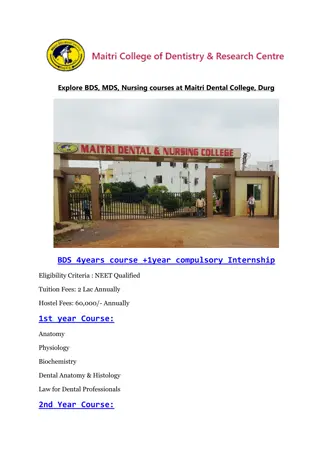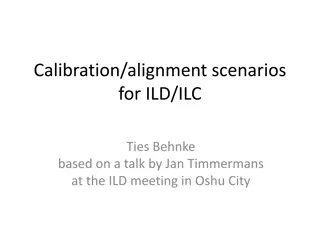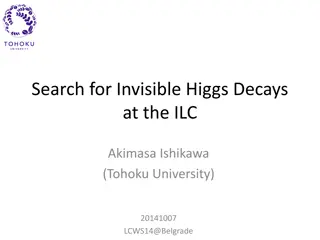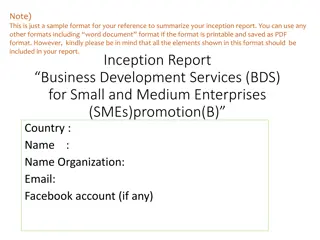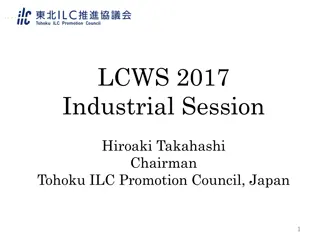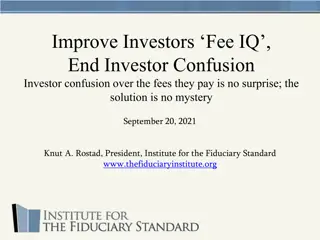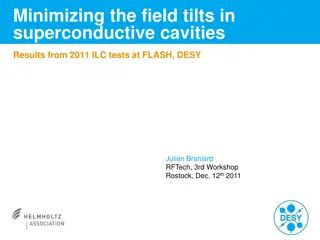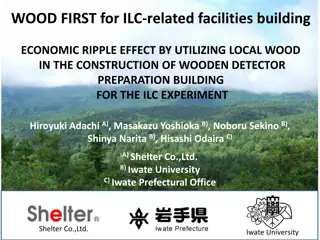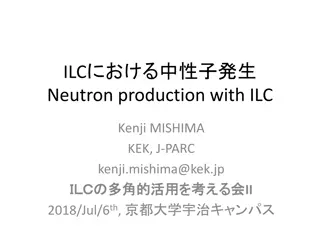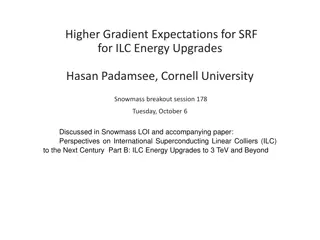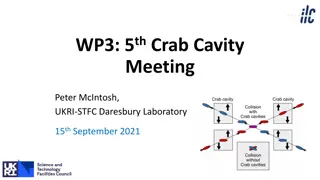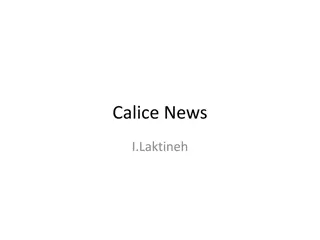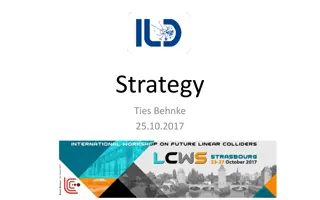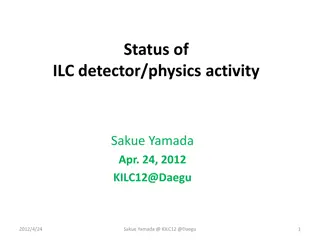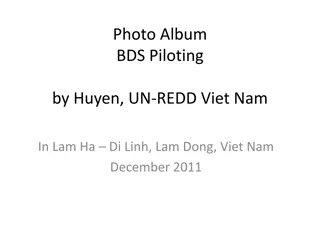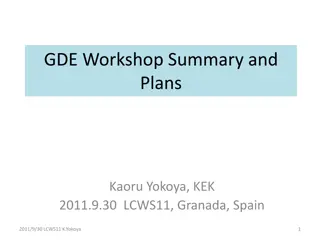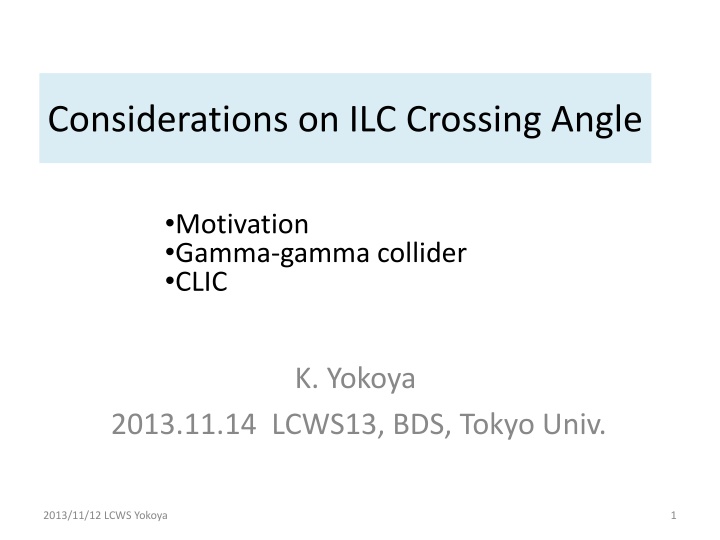
ILC Crossing Angle Considerations and Motivations
Explore the considerations and motivations surrounding the ILC crossing angle, including discussions on gamma-gamma collider possibilities, design issues, and potential trade-offs between different angles. The importance of compatibility with future projects and the impact on luminosity reduction are highlighted.
Uploaded on | 0 Views
Download Presentation

Please find below an Image/Link to download the presentation.
The content on the website is provided AS IS for your information and personal use only. It may not be sold, licensed, or shared on other websites without obtaining consent from the author. If you encounter any issues during the download, it is possible that the publisher has removed the file from their server.
You are allowed to download the files provided on this website for personal or commercial use, subject to the condition that they are used lawfully. All files are the property of their respective owners.
The content on the website is provided AS IS for your information and personal use only. It may not be sold, licensed, or shared on other websites without obtaining consent from the author.
E N D
Presentation Transcript
Considerations on ILC Crossing Angle Motivation Gamma-gamma collider CLIC K. Yokoya 2013.11.14 LCWS13, BDS, Tokyo Univ. 2013/11/12 LCWS Yokoya 1
Motivation ILC will be a green field lab in a newly constructed town Need far future possibilities, as many as possible, though totally unclear now May include, e.g., gamma-gamma CLIC Plasma.... Try not to exclude them from the beginning I would like to propose ILC tunnel compatible to various projects I am not proposing to construct CLIC in Japan As for the crossing angle, reasonable possibilities are ILC 14mrad 20mrad or CLIC 20mrad 14mrad The former has an advantage of accepting gamma-gamma, too 2013/11/12 LCWS Yokoya 2
Gamma-Gamma Issue Design in RDR/TDR TDR: Crossing angle 14mrad Gamma-gamma not mentioned 25mrad needed for gamma-gamma During the study for RDR, rearrangement for gamma- gamma was discussed 14mrad 25mrad Or 20mrad 25mrad 14mrad 25mrad is better because the two dump systems are too close in the case 20mrad 25mrad (Valery) In any case, once going to - , it is absolutely necessary to switch back to e+e- again Not realistic to spend too much time to move to - 2013/11/12 LCWS Yokoya 3
14mr => 25mr A.Seryi, LCWS06 This doesn t look realistic Big CFS work including new main dumps Detector compatibility? Compatible with push-pull? (This plot was created before push-pull) 1400 m additional angle is 5.5mrad (=(25-14)/2) and detector need to move by about 3-4m 2013/11/12 LCWS Yokoya 4
IR Geometry crossing angle angle for outgoing beam 14 mrad 4.5 mrad 20 mrad 10.5 mrad 25 mrad 15.5 mrad The required angle for outgoing beam is proportional to sqrt(N/ z) 2013/11/12 LCWS Yokoya 5
Possible Trade Off Adopt 20mrad for e+e- from the beginning Should be satisfied with 20mrad in - too This should be possible if sqrt(N/ z) is reduced Luminosity may be a bit lower Even in this case a change of beam dump is necessary at switching to - ~10MW photon dump Small angle (1/ ), straight. Telnov proposed diffusion in high-pressure Argon gas. But nobody has thought about its hard ware 2013/11/12 LCWS Yokoya 6
What must be studied for the Compatibility with - ? How large is the luminosity reduction with the smaller angle 20mrad compared with the traditional - design 25mrad ? Decrease N/ zby factor (15.5/10.5)2= 2.2 e.g., reduce N by factor 1.5, increase zby 1.5 What do we lose in e+e- in the change 14mrad 20mrad ? Luminosity does not change Lose some forward angle coverage Angle between solenoid and beam (DID/anti-DID issue) Timing tolerance of crab cavity What else? IR and dump system design must be compatible with later installation of - dump 2013/11/12 LCWS Yokoya 7
CLIC Can ILC tunnel accommodate CLIC in the far future? Difference in the tunnel shape Crossing angle : 14mrad vs. 20mrad Geoid-following vs. laser-straight Offset due to undulator scheme Note: Cost saving by reuse of tunnel is ~1.2B$ CLIC-ILC General Issue Group Interim Report 1 http://ilcdoc.linearcollider.org/record/31959/files/CLIC_ILC_I nterim-Report_Final-1.pdf In addition, save 0.25B$ if reuse Main linac klystron for CLIC driver (but CLIC frequency must be changed 12GHz 11.7GHz) 2013/11/12 LCWS Yokoya 8
Crossing Angle Crossing angle (for e+e-) 20mrad for CLIC (3TeV), 14mrad for ILC More precisely, these are angles between the two linacs CLIC 500GeV adopts 18mrad as the crossing angle with the linac angle 20mrad (This change does not require civil engineering) Are these really necessary? What must be studied? What does ILC lose in e+e- in the change 14mrad 20 mrad ? Luminosity does not change Lose some forward angle coverage Angle between solenoid and beam (DID/anti-DID issue) Timing tolerance of crab cavity What else? What does CLIC lose in the change 12mrad 14 mrad ? 2013/11/12 LCWS Yokoya 9
Laser-straight vs. geoid-following CLIC: laser-straight ILC: geoid-following BDS is laser-straight Too late to change ILC to laser straight Does geoid-following allow 3TeV? Emittance increase by radiation is tolerable The largest issue now seems to be the calibration error of BPMs (beam position monitor) This can be solved in 20 years, I believe 2013/11/12 LCWS Yokoya 10
Offset Due to Undulator Scheme Electron linac and electron BDS is not on the same line due to the undulator scheme About ~2m offset Is this acceptable for 1.5TeV beam with CLIC emittance? ~800m will be available for installing the necessary bends ~ 2m 2013/11/12 LCWS Yokoya 11
Summary If we can make the ILC tunnel compatible (at least not incompatible) to various projects, this will greatly expand the future possibility of the ILC lab and the town We should unify the crossing angle of ILC and CLIC I prefer 20mrad because of the compatibility with gamma-gamma Serious studies should be done in the next half year or at most one year by the time detailed CFS design starts 2013/11/12 LCWS Yokoya 12


